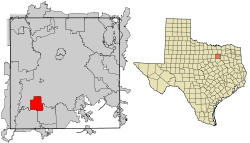Duncanville, Texas
USGenWeb >> TXGenWeb >> Dallas County >> Towns & Communities >> Duncanville, Texas
 |
|
| Latitude |
32°38′47″N 32.646389 |
| Longitude |
96°54′41″W -96.911389 |
| Elevation feet/meters |
725/221 |
| Zip Code | 75116, 75137, 75138 |
| Founded | 1845 |
| GNIS FID | 1334786 |
| Duncanville TXGenWeb | |
| Cemeteries | |
| Library | |
| Local Genealogy Society | |
| Duncanville ISD | |
| Wikipedia | |
| City of Duncanville | |
Settlement of the area began in 1845, when Illinois resident Crawford Trees purchased several thousand acres south of Camp Dallas. In 1880 the Chicago, Texas and Mexican Central Railway reached the area and built Duncan Switch, named for a line foreman. Charles P. Nance, the community's first postmaster, renamed the settlement Duncanville in 1882. By the late 19th century Duncanville was home to a dry goods stores,
|
|||||||||||||||||||||||||||
During World War II, the Army Air Corps established a landing field for flight training on property near the present-day intersection of Main and Wheatland roads.
.... Read More Wikipedia ....
Duncanville is west of the intersection of Interstate Highway 20 and U.S. Highway 67 in southwestern Dallas County. The land on which the city lies originally belonged to the Peters Colony. Settlement began when Crawford Trees arrived from Illinois in 1845 and purchased several thousand acres south of Camp Dallas. Trees donated land in 1855 for the Little Bethel Male and Female School, which also served as a church building until 1881, when citizens constructed the Union Hall House. In 1880 the Chicago, Texas and Mexican Central Railway reached the area and built Duncan Switch, named for a line foreman. Charles P. Nance, the community's first postmaster, renamed the settlement Duncanville in 1882. The Gulf, Colorado and Santa Fe acquired the railroad in 1883 and erected telegraph poles and lines. Though a fire in 1884 destroyed most of the community's commercial buildings, by the late 1800s dry goods stores, a pharmacy, a domino parlor, and a school existed in Duncanville. The Farmers Gin and the Farmers Bank opened there in the early 1900s. Between 1904 and 1933 the population of Duncanville increased from 113 to more than 300. Fearing annexation by neighboring Dallas, Duncanville residents incorporated a 225-acre city on August 2, 1947. When the town's population reached 5,000 in 1962, citizens adopted a home-rule charter with council-manager city government. Duncanville has developed as a Dallas suburb. Its population increased from about 13,000 in 1970 to more than 31,000 in 1988. Local commerce, which formerly centered on Main Street, had by that time expanded to other sites in the town, most notably to shopping centers on the city's west side and along U.S. Highway 67 between Duncanville and Cedar Hill. Duncanville had a population of 35,748 in 1990 and reported 773 rated businesses in the early 1990s. In 2000 the population was 36,081 with 1,307 businesses.
BIBLIOGRAPHY: Duncanville Historical Commission, The History of Duncanville, Texas (Dallas: Taylor, 1976). Kathleen E. and Clifton R. St. Clair, eds., Little Towns of Texas (Jacksonville, Texas: Jayroe Graphic Arts, 1982).
Handbook of Texas Online, Paula Stewart, "DUNCANVILLE, TX"




